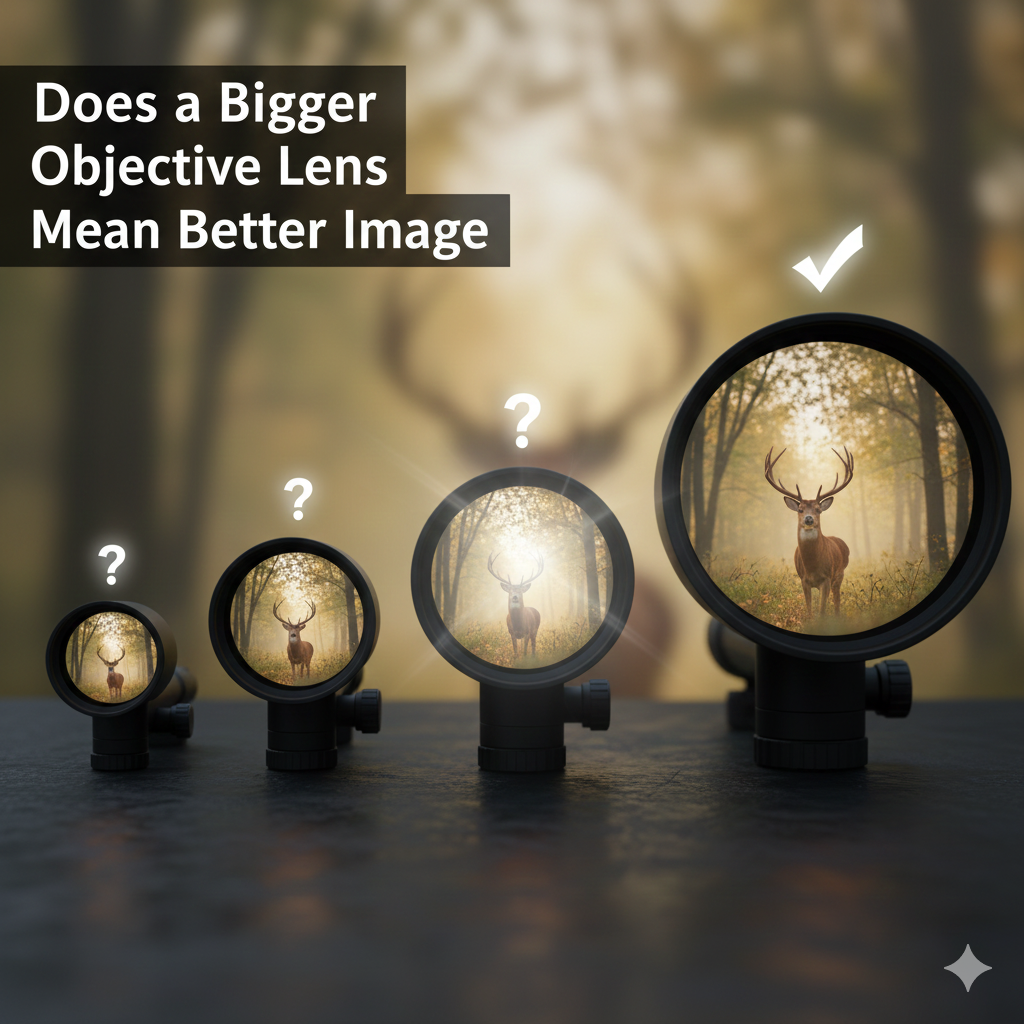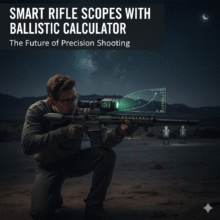Does a Bigger Objective Lens Mean Better Image

For many shooters, the objective lens size is one of the first things they look at when buying a riflescope or binoculars. The common belief is simple: a bigger objective lens means more brightness, more clarity, and therefore a better overall image. At first glance, this sounds logical. After all, a larger piece of glass should naturally gather more light. But in reality, the relationship between objective lens size and image quality isn’t as straightforward as it seems.
There are several optical principles that influence the final image you see through a scope, and while objective lens diameter plays a role, it is far from the only factor that matters. In fact, bigger is not always better. Understanding why requires looking at concepts like light transmission, exit pupil, magnification, glass quality, coatings, and even ergonomics.
In this article, we will break down what an objective lens actually does, how it affects brightness and clarity, when a larger objective truly helps, and when it becomes unnecessary or even disadvantageous. By the end, you’ll be able to confidently choose the right scope for your shooting needs without falling for common misconceptions.
What the Objective Lens Actually Does
The objective lens is the large front lens of a scope. It serves one fundamental purpose: to collect light and send it to the rest of the optical system. The more light it gathers, the brighter and more detailed the image can potentially become. However, the key word here is “potentially.” The benefit depends heavily on the conditions you’re shooting in and how the rest of the scope is designed.
For example, a 56 mm objective lens naturally gathers more light than a 40 mm objective. But that increased light is only useful if your eye can actually make use of it. In many situations, especially in bright daylight, your eye simply doesn’t need the extra light, meaning the larger objective doesn’t provide any noticeable improvement in image quality.
Why a Bigger Objective Lens Doesn’t Always Mean Better Image
The belief that a bigger objective lens always gives a brighter, clearer image comes from an oversimplified understanding of optical physics. A larger lens does indeed capture more light, but the exit pupil determines how much of that light your eye can actually use. The exit pupil is calculated by dividing the objective lens diameter by the magnification. This means a 50 mm objective at 10x magnification provides a 5 mm exit pupil, while a 40 mm objective provides 4 mm.
However, the average adult human eye can only accept around 4–5 mm of light in normal lighting conditions. Even in very low-light situations, the eye’s maximum dilation is around 7 mm, and that applies mostly to young people. Therefore, unless the exit pupil exceeds what your eye can use and the lighting conditions require it the extra lens size doesn’t contribute to image quality.
In broad daylight, even a small objective can deliver more light than your eyes can handle. That’s why some of the clearest and sharpest optics in tactical environments, such as LPVOs, red dots, and prism scopes, use much smaller objective lenses.
How Magnification Changes the Importance of Objective Lens Size
Magnification has a major effect on whether a larger objective lens is useful. At higher magnifications, the exit pupil becomes smaller. This is why long-range shooters—who often work at 16x, 20x, or even higher—benefit more from larger objective lenses. A 56 mm lens at 20x provides a noticeably larger exit pupil than a 40 mm lens at the same magnification, which translates into a brighter, more usable image.
For hunters or mid-range shooters using low to moderate magnification (3x–12x), the difference between objective sizes can be negligible. The exit pupil remains large enough for the human eye regardless of whether the objective lens is 40 mm or 50 mm. The advantages of oversized objectives simply don’t show up until magnification increases dramatically.
The Role of Glass Quality and Coatings
A crucial fact often overlooked in the “bigger is better” debate is that glass quality matters far more than lens size. A high-quality scope with a 40 mm objective can easily outperform a cheap 56 mm scope. Superior coatings lead to better contrast, sharper edges, richer colors, and reduced glare.
Lens coatings determine how effectively light passes through the glass surfaces. Fully multi-coated surfaces can transmit significantly more usable light than single-coated or uncoated lenses. This is why premium optics with smaller objectives often outperform larger, budget-era scopes. The clarity you perceive has less to do with raw light entry and more to do with how efficiently that light is processed.
Where Larger Objective Lenses Truly Make a Difference
There are times when a larger objective lens genuinely offers improved performance. Shooters who spend time in deep woods, dense cover, or low-light situations benefit from the brightness boost a 50 mm or 56 mm lens provides. Dawn and dusk two of the most common hunting times are notorious for poor light conditions. In these moments, a larger objective allows shooters to identify targets and make ethical shots when smaller lenses struggle.
Long-range shooters also benefit because they calculate shots at high magnification. Under these conditions, a larger objective helps maintain a larger exit pupil, which results in a brighter and more stable image. When your magnification goes up, the brightness naturally goes down due to a shrinking exit pupil. Increasing the objective lens size is one way to counter this effect.
When a Bigger Objective Lens Becomes a Disadvantage
One of the least-discussed aspects of large objective lenses is how they impact the rifle’s ergonomics and handling. Bigger objectives require taller scope rings, which raises the optic higher above the bore line. This can force the shooter into an awkward cheek weld unless they use an adjustable cheek rest.
Larger lenses also add weight sometimes significantly. A 56 mm scope can feel top-heavy, especially on lightweight hunting rifles. This extra forward weight changes the balance of your firearm, making it harder to carry over long distances. Moreover, large scopes tend to be bulkier, making them less suitable for fast-moving or close-quarters shooting.
In addition to weight and mounting issues, a big objective lens can introduce more parallax sensitivity. Parallax adjustment becomes more critical as the objective grows, demanding more precise setup and potentially slowing the shooter down.
Real-World Usage Scenarios and Ideal Lens Sizes
The ideal objective lens size depends heavily on your shooting style. A hunter in thick forests who often shoots during sunrise or sunset might prefer a 50 mm lens. A long-range precision shooter working at 20x or more may require a 56 mm objective to maintain clarity at high zoom levels.
On the other hand, a tactical shooter using an AR-15 for home defense or competition typically gets no benefit from a large objective. For these shooters, a smaller, lighter optic improves speed, balance, and maneuverability. Likewise, mountain hunters and backpackers often choose scopes with 40 mm objectives because they offer enough brightness without the bulk.
Misconceptions About Objective Lens Size
Many shooters assume that a larger objective automatically means better magnification, a wider field of view, or superior image quality. In reality, magnification depends on the eyepiece, not the objective lens. Field of view is also determined by the internal optical design, not the front lens size. Clarity depends almost entirely on glass quality and coatings.
These misconceptions persist because objective size is easy to compare on paper, while the subtle factors that truly influence optical performance require more experience and understanding.
So, Does a Bigger Objective Lens Always Mean a Better Image?
The answer is no. A larger objective lens can provide better brightness, especially in low-light or high-magnification conditions, but it does not guarantee a better image. Many shooters will never fully benefit from anything larger than 40–50 mm, especially if they primarily shoot during the day or use low to moderate magnification.
The key is choosing an objective size that matches your real-world shooting conditions. If you regularly shoot at dawn, dusk, or extreme distances, a larger objective will help. If you value mobility, balance, and simplicity, a smaller objective may serve you better.
Conclusion
The idea that a bigger objective lens automatically leads to a better image is a myth. While larger lenses can provide real benefits in certain conditions, the overall quality of an optic depends far more on glass quality, lens coatings, magnification, and how the scope is matched to your shooting style. Rather than chasing the biggest lens, shooters should focus on selecting the right balance of size, weight, brightness, and optical performance for their specific needs.






